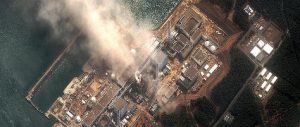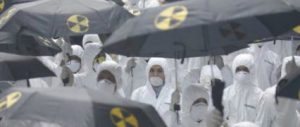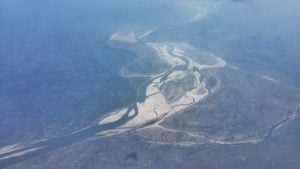In the space of a couple of decades, China has become a major player in the global nuclear sector. With by far the largest number of reactors under construction of any country in the world, and further reactors on order, it is seen as a vital market for uranium, a testing ground for new reactors designs and, increasingly, a potential partner for nuclear developments across the world.
But the Fukushima crisis in Japan has had a significant – and under reported – impact on Chinese nuclear developments, triggering a freeze on the start of new construction, a re-consideration of the safety standards of domestic designs and unprecedentedly visible opposition to the building of new, inland nuclear plants. While an announcement was made by the State Council last week that the ban will be lifted shortly, the events of the last 15 months will still result in a failure to meet China’s current five-year plan on nuclear development and, depending on how things develop, its 2020 objectives as well.
The global clout of China’s nuclear sector is such that the impacts of its decisions stretch far beyond the nation’s borders. From France to Namibia, from reactor designers to uranium-mining firms, the industry will be waiting anxiously for news from China.
China came relatively late to the civil nuclear industry: it started construction of its first commercial reactor only in 1985. As of May this year, the country had 16 reactors in operation, which in 2011 provided 1.85% of the country’s electricity, the lowest share of any country with nuclear power. But, despite its late arrival to the party, China was – until Fukushima – proving an energetic player, with an impressive recent history of construction starts. Today, it has 26 reactors under construction, representing 39% of global new build.
But Fukushima changed the picture. Three days after the 2011 tsunami triggered equipment failures at the Japanese plant, Xie Zhenhua, vice chairman of China’s top economic planning body, the National Development and Reform Commission, was quoted by Bloomberg as saying “[e]valuation of nuclear safety and the monitoring of plants will be definitely strengthened.”
Then, an account of a meeting of the State Council, chaired by premier Wen Jiabao, in mid-March 2011 included the following: “We will temporarily suspend approval of nuclear-power projects, including those in the preliminary stages of development….We must fully grasp the importance and urgency of nuclear safety, and development of nuclear power must make safety the top priority.” As a result, a new China National Plan for Nuclear Safety with short-, medium- and long-term actions was ordered, and the construction of new plants suspended pending its approval.
A May 31 meeting of the State Council is said to have given provisional approval to both the safety plan and a set of goals for 2020. If implemented, these proposals will require some of the existing reactors to undertake safety modifications to meet new standards on earthquakes and flooding. However, it is still unclear when construction on new projects might begin again, or when the proposal for a new safety standard will be released for public comments.
It is suggested the delay has been partly caused by uncertainty over the strategic direction for future reactor designs, and in particular whether future construction would be dominated by China’s second-generation CPR 1000 design or move towards greater deployment of third-generation designs from overseas.
China has not yet fully developed its own third-generation design and would have to rely initially on the European Pressurized Water Reactor (EPR) or the American AP1000 reactor. The potential move towards much greater, or even total, dependence on the most modern design is affected by conflicting concerns: the higher costs of the international design and greater confidence in the safety standard.
Tange Zede, a member of China’s State Nuclear Power Technology Corporation (SNPTC), was reported in Nuclear Intelligence Weekly as saying the domestically designed CPR-1000 could not even meet the national safety standards issued in 2004, let alone the most up-to-date international standards. Zede stated that “unless the constructed second generation reactors are renovated, they should not be allowed to load fuel and start operation.”
Historically, international nuclear vendors have sought to construct their latest models in China. Russia’s reactor-exporting company Atomstroyexport provided its latest design, the AES-91, and equipment for units one and two at Jiangsu province’s Tianwan power plant, which was completed in 2007. It is said that two further reactors will be commissioned, but no date has been set for construction.
Atomic Energy of Canada Ltd (AECL) built two of its heavy-water reactors at the Qinshan phase-three plant in Zhejiang, on China’s east coast, but despite the fact these were completed in 2002 and 2003 respectively, no further orders have been placed. Finally, the French utility EDF was engaged in the construction of two reactors at Daya Bay, south China, which were completed in 1994 using technology from French firm Framatome, now AREVA. Two further reactors at phase one of the Ling Ao plant in Shenzhen, also in the south, were built using Framatome equipment, though with a larger domestic contribution. But by the time it came to phase two, a domestic Chinese design was used.
Today, the world’s major international reactor vendors, notably AREVA and Westinghouse, are building their most advanced designs in China. In the case of Westinghouse, the AP1000 is the company’s flagship third-generation design, and China is its only sale. The contract, worth around US$5.3 billion (34 billion yuan), is for construction of four reactors, including transfer of both reactor technology and back-end services, particularly waste management.
Construction of these four units, two at Sanmen in Zhejiang province and two at Haiyang, further north in Shandong province, is under way, though delays of six to 12 months are reported. For the first unit at Sanmen, the slippage is said to be due to design changes post-Fukushima. For the remaining three units, supply-chain issues relating to the increased use of local components are blamed. If reports are accurate, use of domestic parts across the series of the four reactors will increase from 30% to 70%, and any future reactors will be built with Chinese components alone.
The estimated construction costs of the AP1000 are also quoted as rising. In 2009, it was said they would cost US$1,940 per kilowatt (12,400 yuan), but the latest figures range from US$2,300 to US$2,600 per kilowatt. While this is far below the estimated costs of any other third-generation project, globally it is higher than the reported costs for China’s CPR 1000 at US$1,800 per kilowatt.
In November 2007, AREVA announced the signing of an €8 billion (US$11.6 billion) contract with China Guangdong Nuclear (CGN) for the construction of two EPRs in Taishan, in south China’s Guangdong province, and said it would provide all the materials and services required to operate them. The Taishan project is owned by Guangdong Taishan Nuclear Power Joint Venture Company Limited, a hook-up between EDF (30%) and CGN. First concrete was poured in October 2009, and unit one was expected to begin operating in 2013, followed by a second unit in 2014.
Two other EPR reactors are being built in Europe, one in Finland and one in France, but are both running at least 100% over budget and four to five years behind schedule. The delays are such that the Chinese reactors may now be operational before those being built in Europe. Completing the EPRs in China to time and budget will be a vital test for AREVA, which the company will hope can offset its bad experience in Europe. Troubles closer to home are said to be contributing to its lack of sales in other parts of the world, such as the United Arab Emirates.
China is also stepping up its nuclear export activity. The most consistent example is Pakistan, which China has supplied with equipment for two reactors at Chashma in Punjab. Construction of units three and four reportedly began at the end of 2011, with China Zhongyuan Engineering as the general contractor and China Nuclear Industry No. 5 Construction Company as the installer. Finance is also coming from China.
It doesn’t stop with Pakistan. In recent months, the Chinese industry has been linked with many other projects around the world. The visit of Turkey’s prime minister, Recep Tayyip Erdogan, to Beijing in April was used to discuss China’s assistance for a proposed nuclear-power station at the Turkish city of Sinop. Other possible deals include the sale of a plant to South Africa and a nuclear co-operation agreement in Saudi Arabia, while there has been speculation over potential Chinese ownership of the energy company Horizon Nuclear Power, established by utilities Eon and RWE to build nuclear plants in the United Kingdom, but now up for sale.
To fuel the country’s expectation of a rapidly growing nuclear sector, two companies – CGN and China National Nuclear Corp (CNNC) – are permitted to import uranium. To meet official fuel requirements, they are set to increase imports from around 3,600 tonnes per year in 2010 to some 10,000 tonnes in 2020. Of the two firms, CGN has been the more successful over recent years and has signed a number of deals. In November 2010, its leaders inked a 10-year agreement for the supply of 24,200 tonnes of uranium from Kazakhstan’s Kazatomprom.
In addition, CGN and Chinese equity funds each have a 24.5% share in AREVA’s mines in Namibia, South Africa and the Central African Republic, which could provide an additional 40,000 tonnes of uranium starting in 2022. CGN signed another deal in November 2010 with Cameco of Canada for the supply of 13,000 tonnes of uranium through 2025.
More recently, in February this year, CGN completed a takeover of Extract Resources, which is developing Africa’s largest known uranium resource. CGN, together with the China-Africa Development fund paid €2.2 billion (US$2.7 billion) for the company and associated companies, such as Kalahari Minerals. The CGN activity contrasts starkly with the limited success of CNNC, which has secured little supply outside of China despite attempts in Mongolia, Kazakhstan and Niger. Though, in light of its ambition to secure 2,500 tonnes of uranium a year by 2015, CNNC is likely to increase its activity in the market, and there are suggestions it might take a stake in AREVA’s new project in Niger.
Prior to the accident at Fukushima, China’s 12th Five-Year Plan anticipated 43 gigawatts of nuclear power in operation by the end of 2015. Meeting this target would have required the completion of all reactors under construction at the end of 2010, plus those scheduled to start in 2011. It therefore cannot be met. A report on implementation of the 12th Five-Year Plan, published by the China Electricity Council in March estimated that China’s nuclear-generating capacity would reach 80 gigawatts by 2020. But the suspension of the start of new construction and the uncertainty over the strategic direction for future designs make meeting this 2020 target highly unlikely.
Public opinion could also pose an obstacle. In a poll carried out by research agency Ipsos MORI after Fukushima, 42% of those surveyed in China were supportive of nuclear power – but 48% were opposed. It is also reported that public opposition and environmental concerns have led to the delay in construction of three inland nuclear power sites. In March this year, opposition to the proposed Pengze power plant in Jiangxi erupted into the public sphere on a scale not previously seen when local authority documents critical of the project were posted on the internet.
Given nuclear’s small contribution to China’s electricity supply, a doubling or trebling of new-build capacity won’t significantly alter the electricity mix or, for that matter, Chinese emission trajectories. However, the future direction of its choice of reactor design domestically could fundamentally change the number of orders for a particular manufacturer. This is something global companies are well aware of, though they should note that – so far – China has not deployed any foreign reactor design at scale, rather ordering a couple and then largely carrying on with domestic designs.
Fukushima has already had a significant impact on the Chinese nuclear sector and, more than 15 months after the accident, the moratorium on new construction starts remains in place. The questions are now, one, will future orders be placed at the pre-Fukushima rate? And, two, what new design safety standards are required?
The answers to these questions are not only eagerly awaited in Paris and Tokyo, the homes of AREVA and Westinghouse, but also uranium suppliers in Africa and prospective nuclear builders in the United Kingdom, Turkey and Saudi Arabia, to name but a few. China’s nuclear developments probably matter more to the rest of the world than they do to China.
Antony Froggatt is a senior research fellow in the energy, environment and development programme at Chatham House – The Royal Institute of International Affairs.
This article is adapted from a section of the forthcoming version of the “World Nuclear Industry Status Report”, by Mycle Schneider and Antony Froggatt.
This article is published here as part of Nuclear Enery and Developement Programme, which is supported by the Heinrich-Boell Foundation.
Homepage image by AECL



